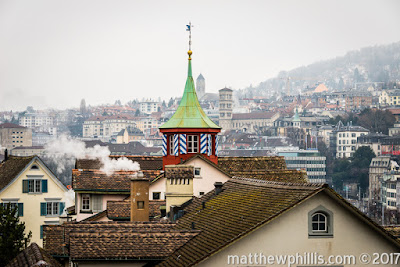 |
| From the mountains to the city. |
 |
| The city of Zürich. |
 |
| A fountain with the flag of the city. |
 |
| I just love Swiss fountains - interesting and functional! |
 |
| View of the Limmat River and the East bank from the viewpoint. |
 |
| City selfies. |
 |
| Zürich rooftops. |
 |
| Downtown Zürich. |
 |
| the Grossmünster of Zürich. |
 |
| Pretty streets of Zürich. |
I enjoyed walking around the city and seeing the sights, despite the cold and terrible weather. At least it wasn't raining, so my spirits weren't dampened apart from the fact that I knew the city wasn't being shown in it's best light. The river is the main attraction, apart from the lake, and from a viewpoint on the West bank I could imagine what it would look like on a sunny day. The Zürich cathedral is called Grossmünster, or 'Great Minster,' and is a Romanesque Protestant church that sits just off the river, commanding a view of the lake and the rest of the city. Built on the site of another church, said to have been commissioned by Charlemagne (Charles The Great), a Frankish King in the 8th Century - he chose the site when his horse fell to it's knees, over the tombs of Felix and Regula, the patron saints of the city. Members of the Theban legion, they were threatened to be executed along with the rest of the unit in 286 due to their mass conversion to Christianity, the two brothers we eventually caught, tried and executed in Zürich. After their heads were cut off, the miraculously stood, picked up their heads and walked forty paces uphill and prayed, before lying down and dying. This is the spot where the new church would be build - the present-day Grossmünster, which took 120 years to build (1100-1220). Sounds silly I know, but recent archaeological evidence confirms the presence of a Roman burial ground at the site, so maybe it was true... apart from the decapitated bodies getting up and walking. Inside, sadly, is nowhere near as large or as impressive as the outside - it was small, had a plain ceiling and no impressive stonework at all.
 |
| Simple yet beautiful - that's Switzerland. |
 |
| The busiest train station in Europe. |
 |
| The Bern Zytglogge. |
 |
| Albrecht von Haller at Bern Uni. |
 |
| Houses and church along the river. |
 |
| Sunset in Bern. |
 |
| Anna Seiler Fountain. |
 |
| Bern's main street. |
 |
| Beautiful houses in the University suburb of Bern. |
 |
| Bern after a dusting of overnight snow. |
 |
| The child-eating Ogre. |
 |
| Another unique Bern fountain. |
 |
| The scariest (and also one of the most interesting) fountain statues I've ever seen! |
 |
| Snow and sunshine - perfect day for a walk! |
 |
| The Mediveal City of Bern. |
 |
| Bern's Aare River. |
 |
| Houses overlooking the river, with the Minster behind. |
 |
| Bern's Parliament building as people 'skate in' the New Year. |



No comments:
Post a Comment